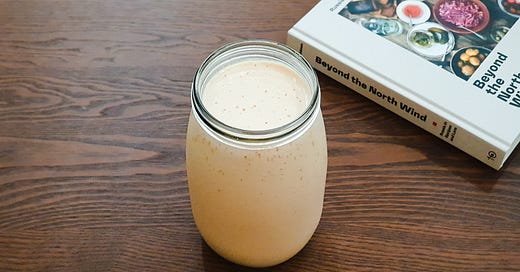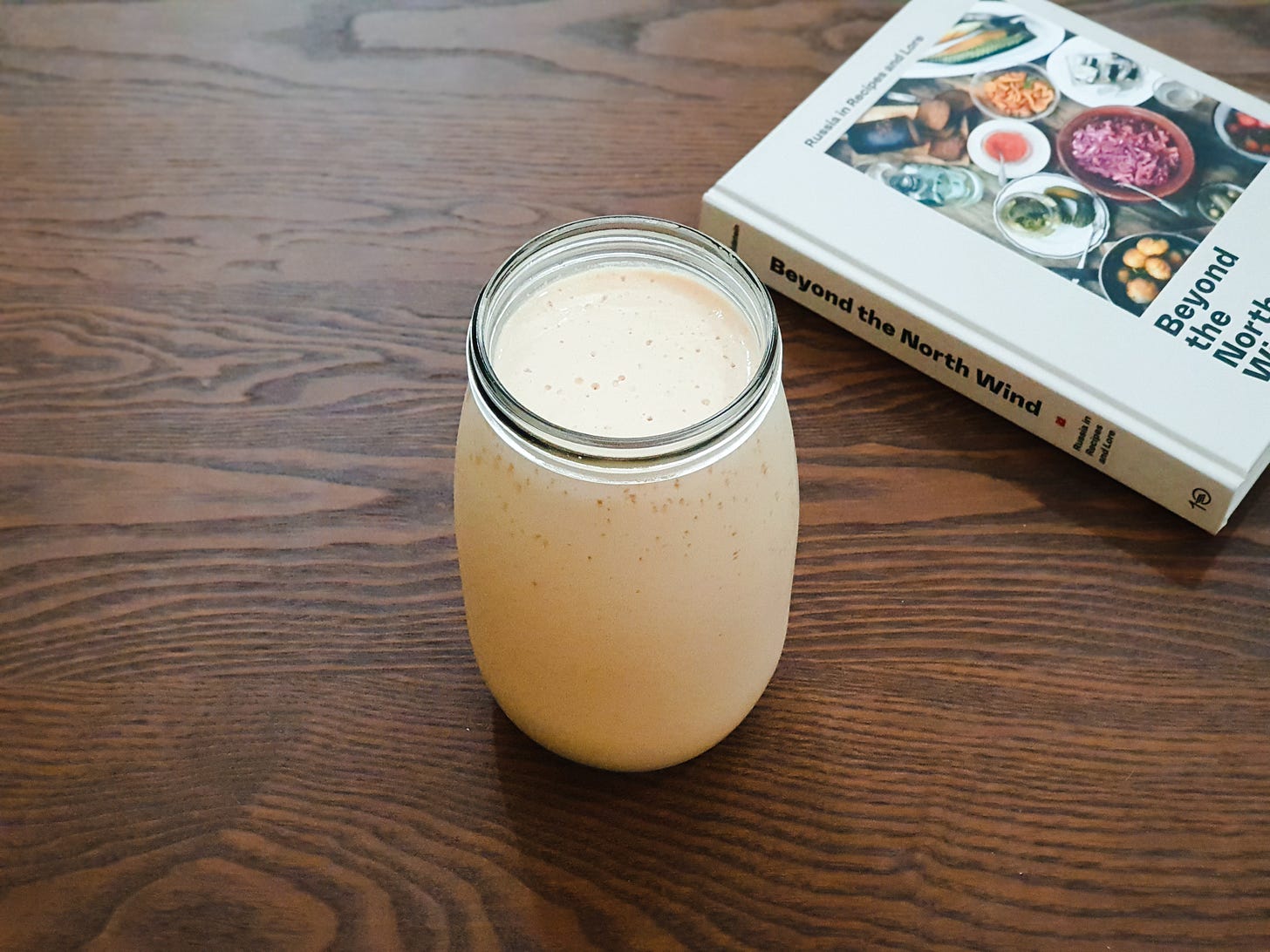Ryazhenka: A Dance of Heat, Time, and Microbial Life
Step-by-step recipe with detailed process explanation
Ryazhenka, a cherished dairy delicacy from Eastern Europe, is more than just a fermented milk drink; it's a testament to the intricate interplay of heat, time, and microbial life.
The Maillard Reaction: The Heart of Ryazhenka's Flavor
At the core of ryazhenka's unique taste and color is the Maillard reaction, a non-enzymatic browning process that occurs when amino acids (the building blocks of proteins) react with reducing sugars like lactose in the milk. This reaction begins at temperatures around 140°C (284°F) but becomes particularly noticeable at 150-160°C (302-320°F) where it imparts a golden-brown hue and a complex, caramelized flavor to the milk.
During the 4-5 hour baking period, the Maillard reaction unfolds gradually. The heat causes the proteins in the milk to denature, meaning they lose their native structure and begin to coagulate. This coagulation thickens the milk, giving ryazhenka its characteristic creamy consistency. Simultaneously, the lactose in the milk reacts with the free amino groups of the proteins, producing a myriad of flavor compounds that contribute to the rich, slightly sweet taste of ryazhenka. The caramelization of lactose also reduces its sweetness, balancing the overall flavor profile.
Protein Coagulation: The Foundation of Texture
The velvety texture of ryazhenka comes from how milk proteins, especially casein, react to changes in pH. As bacteria ferment the milk, they produce lactic acid, which lowers the pH and makes the milk more acidic. This acidity causes the casein proteins to lose their natural charge, making them stick together and form clusters. These clusters trap water and fat, creating a thick, smooth texture. The right pH level is key — if it’s too high, the milk stays runny, and if it’s too low, the texture can become grainy. In ryazhenka, the slightly acidic pH hits the sweet spot for a rich, velvety result.
Fermentation
After the milk has been baked and allowed to cool, it is inoculated with kefir grains or a starter culture containing lactic acid bacteria. This fermentation stage, typically conducted at room temperature (20-25°C or 68-77°F), lasts 24-48 hours. The bacteria consume the lactose, producing lactic acid, which lowers the pH of the milk.
As the pH drops, several things happen:
The acidity causes further coagulation of the milk proteins, contributing to the thick, spoonable texture of ryazhenka.
The decrease in pH also inhibits the growth of spoilage organisms, preserving the milk and extending its shelf life.
The fermentation process imparts a tangy flavor, balancing the caramel sweetness from the Maillard reaction.
The final pH of ryazhenka typically falls between 4.5 and 4.7, which is low enough to ensure a pleasantly tart flavor while maintaining a smooth texture. The lactic acid also contributes to the product's digestibility, making ryazhenka a probiotic-rich food that supports gut health.
Reduced Lactose Content
Throughout the baking and fermentation process, lactose undergoes significant transformation. Initially, some of the lactose participates in the Maillard reaction, contributing to the development of flavor and color. During fermentation, the remaining lactose is metabolized by the lactic acid bacteria, producing lactic acid. This not only lowers the pH but also reduces the lactose content, making ryazhenka more tolerable for individuals with lactose sensitivity.
To make fermented baked milk, or ryazhenka, follow these steps:
Ingredients:
1 liter (1 quart) of full-fat milk (preferably raw or pasteurized, but avoid ultra-pasteurized)
1-2 tablespoons of kefir grains
Instructions:
Bake the Milk:
Preheat your oven to 160°C (350°F).
Pour the milk into an oven-safe pot or dish (preferably with a thick bottom to prevent burning).
Place the dish in the oven and let the milk bake for 4-5 hours, until it develops a golden-brown crust on top. This caramelizes the lactose, giving the milk a rich, slightly sweet flavor.
After baking, let the milk cool to room temperature.
Ferment the Milk:
Once the baked milk has cooled, pour it into a glass jar or fermenting vessel.
Add the kefir grains to the cooled milk and stir gently.
Cover the jar with a breathable cloth or paper towel secured with a rubber band to keep out dust while allowing air to circulate.
Fermentation Process:
Leave the jar at room temperature (around 20-25°C or 68-77°F) for 24-48 hours.
The fermentation time can vary depending on the temperature and your taste preference. Check the taste after 24 hours and let it ferment longer if you want a tangier flavor.
Strain and Store:
Once the milk has fermented to your liking, strain out the kefir grains using a plastic or stainless steel strainer.
Transfer the fermented baked milk (ryazhenka/varenets) to a clean jar and refrigerate. It will keep for up to a week.
Reusing Kefir Grains:
Rinse the kefir grains with cool, non-chlorinated water and reuse them for your next batch of kefir or fermented baked milk.
Tips:
The longer the fermentation, the thicker and tangier the ryazhenka will become.
You can experiment with different types of milk to achieve various flavors and consistencies.
Enjoy your homemade ryazhenka!
Making ryazhenka is a journey through Eastern European culinary tradition. From baking to fermentation, each step unveils the art and science behind this beloved drink. Embrace the process, experiment with flavors, and continue to celebrate the vibrant heritage of fermentation in your kitchen.

 Tiktok failed to load.
Tiktok failed to load.Enable 3rd party cookies or use another browser
connect with us on Instagram:
Denis Pashkov
cosmos society





